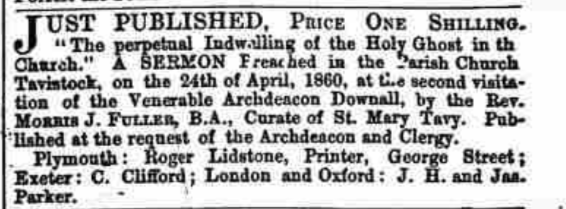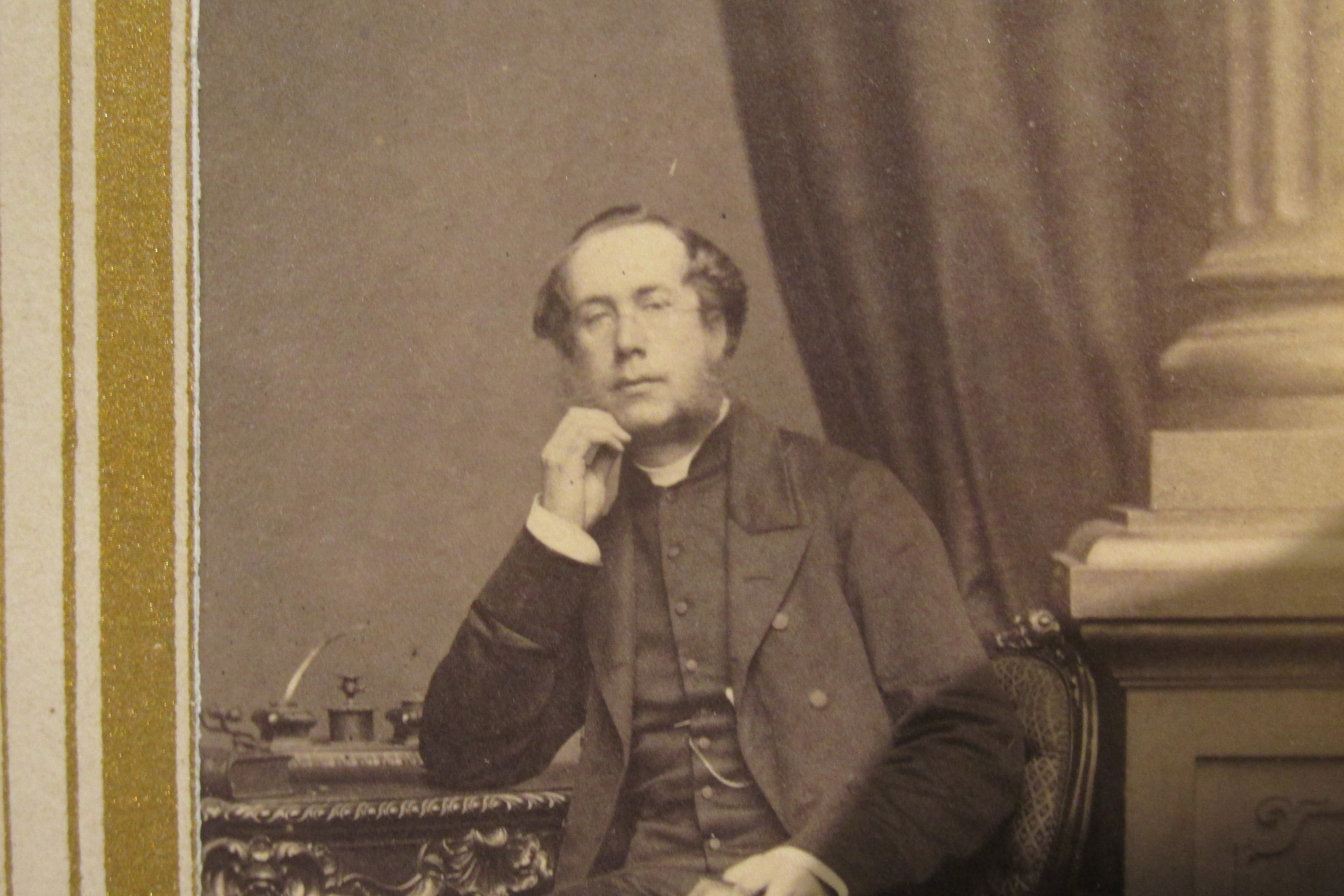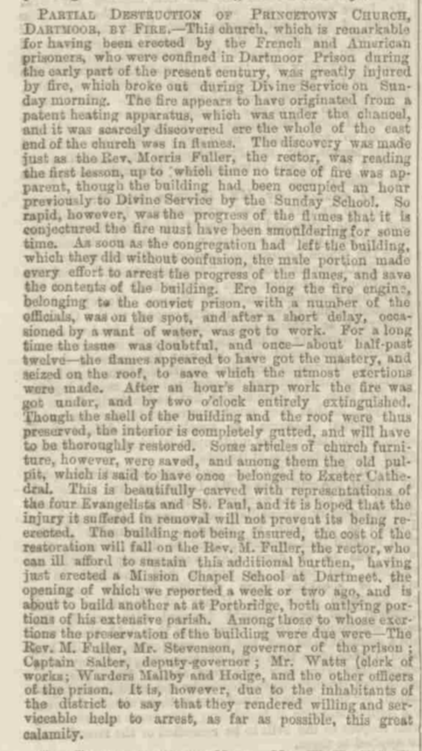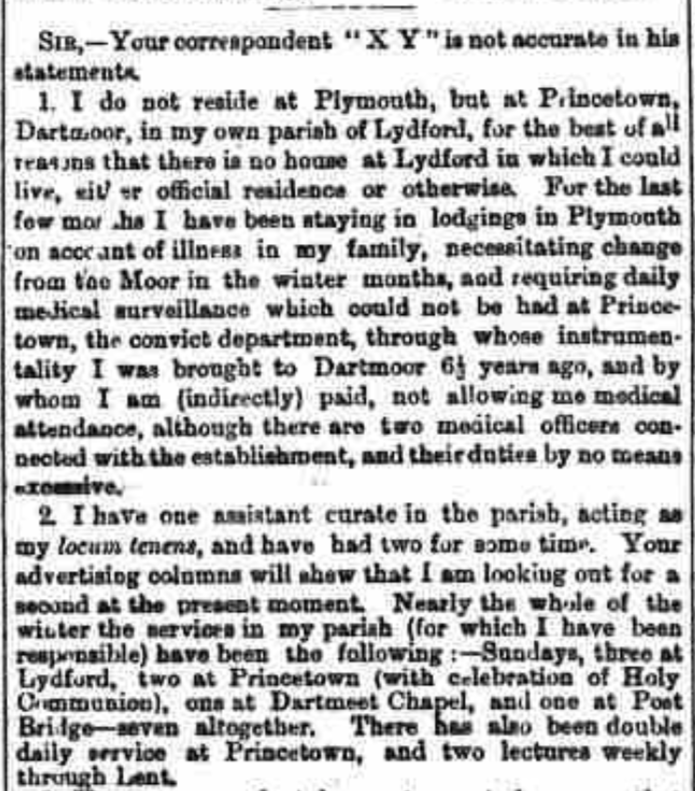Part 4
The Devon Years
In researching the life of Morris Fuller, as a first port of call, the surviving C.V.s
published by Crockford’s Clerical Directories and Venn’s Cambridge Alumni were
duly consulted. However as further research has shown these are not always
entirely accurate. Sometimes attributable to mere typograhical error, there are
one or two instances that point, with hindsight, to a more blatent obfuscation,
particularly in regard to his pedigree, both real and imagined.
On December 21st. 1856 Morris Fuller was ordained Deacon by the Bishop of
Bath and Wells on the testimony of the elderly Bishop of Exeter who ordained
him priest on May 30th. 1858. On graduating B.A, in 1855 he held a post of
Assistant Master at Brighton College for a year.
His first Curacy was of Buckland-Monachorum and Horrabridge1857-9, and
from there to St Mary Tavy 1859-62 when he was also 2nd Master at Tavistock
grammar school, and adding the Curacy of N. Huish 1861-2. At this point the
Cambridge Alumni entry credits him with being Chaplain at Princetown 1862-1879.
It would seem he first became perpetual curate and incumbent of the newly
consecrated church of St Michael and All Angels in Princetown and then adding,
by presentation of the Prince of Wales, the Rectory of Lydford in 1867-1879 after
which time he moved to East Molesey.
These bare facts account for how he made his living by his tenure of
“ [geographically] one of the largest parishes in England”
I had thought at one point on seeing the words “Chaplain at Princetown”, the
village in which Dartmoor Prison is situated, that he had been moved by the
plight of his imprisoned father to do his Christian best for the convicts as Prison
Chaplain. However, such a position would have given him precious little
opportunity for any other pastoral activity at a time when the penal Systems of
Separation and of Silence would have required his daily full time attendance at
the Prison for services and prisoner visiting. He would have also been in charge
of prisoner education via the schoolmasters appointed to the prison.The position,
Prison Chaplain, is not to be confused with what the 1882 edition of Crockford
describes as Government Chap. at Princetown 1862-1879 which is a reference
to the church as a Government Chapel, since they provided the stipend.
Having achieved an indisputably respectable situation in life he then married
Helen Natali Edgington in Battersea on the 29th December 1859 and they
returned to Tavistock to live. According to the 1861 Census they were living in
Devonshire Terrace, wife Helen and 4 month old son, Morris Natali. He confirms
that he is ”Curate of St Mary Tavy - 2nd Master of the Grammar School Tavistock,
Bachelor of Arts Cambridge” an entry only matched in length by an MD and JP
occupant of the street further up the page!
*************
In June 1860 we find notice, possibly for the first time, of a published sermon
from the pen of Morris Fuller:

As ever, recourse to the British Newspaper Archive on my part adds hugely to
this scant information, and though he is not much in evidence in the newspapers
in this early period, what does surface shows unquestionably that he started
his ministry in the same forthright way he maintained to the end of his life in
Marylebone. His position required that he would be represented on a raft of
committees and boards very often as chairman and in addition to evangelising
the Gospel both home and abroad, he was keen to promote the developement
of the railway network in the county. To begin at the beginning however, we find
this clipping from his Tavistock days shows a pulpit style and a mission that was
to be one of the hallmarks of his life's work:

and continues:

The truth of the statement in the press clipping below from 1864 that he had been
curate of Princetown since 1858 is questionable but he was certainly perpetual
curate by 1862 and Morris J. Fuller M.A. in 1863. The consecration of St Michaels
took place on October 28th and a sermon preached ther within the octave of that date
entitled "The teaching of the Christian Altar" was published soon after.



The complaints made in this report were more than adequately corroborated in
the following letter to the paper:
THE CHURCH AT PRINCETOWN
To the Editor of the Western Daily Mercury
SIR - It may perhaps answer some good purpose to make known the effects
produced by the late outrages committed by the curate of Princetown chapel
on the people generally , on this wild moor, by turning their quiet place of worship
upside down, so as to disgust every sense of propriety. We should have
rejoiced in our little sanctuary being consecrated. We would have met Mr Fuller
in every way constituent with the simple worship procured by our forefathers,
who believed that He who should be worshippe, “dwelleth not in the temples made
with hands” but with the humble and contrite spirit, and has promised to meet such
in His house, not because of its beautiful architecture, or the bowings and turnings
about and the mountebank actions of the acting minister, but because they come
to worship in spirit and in truth. The curate should seek to win sould to Christ,
instead of insulting their good sense, and violating their rights, as he has done by
taking away their seats, and introducing his gew-gaws, without consulting their
taste or seeking for any co-operation? No; he has not had any meeting with his
parishioners nor has he respected their rights enough to tell them what he was
going to do. The result is that many who regularly attended for years with their
families, and loved their little sanctuary, now fel that they cannot countenance
such ultra decoration, nor listen to the praise of the saints, nor feel interested in
the disquisition on the use and meaning of the candle-sticks on the so-called altar.
We want Christ and His gospel set before us - not ritualism and Popish ornaments -
to incite us to believe on Him who has promised that “ where two or three are met
together in His name He will be with them”
We do hope that some effort will be made to restore our little church to its former
simple state. We cannot believe that the Government would have allowed the
prisoners to work for weeks at the church, and suppy material to a large extent,
had it been known the use their services were applied to, and the misappropriation
of Government property; nor contribute £150 a year to the minister’s stipen, to
drive their officials to absent themselves , and wander about on the Lord’s-day,
having no place where they refresh their sould, and gan strength for the coming
week. One thing we assuredly will do: we will memorialise the Bishop for the
removal of the objectionable ornaments in our church; and we also hear that the
officers of the Prisons will apply to Colonel Henderson for convenience to be
made for them to attend the services in the Prison Chapel, where they will be
sure to hear the Gospel Truth from the excellent chaplain there.
Yours truly,
A DARTMOOR MAN.
Prince-Town, [3] November 1864
By 1865 he is into publishing mode with such showstoppers as:

which is undoubtedly a distillation of "an extemporary address" (or perhaps
blatent networking?)as reported in the Western Morning News, given at the
Norwich Church Congress in October 1865,
"in which he reviewed the history of the Court of Appeal; shewed that the
jurisdiction of the present courts in questions of doctrine was, upon its founder's
(Lord Brougham's) own confession, accidental; and gave seventeen reasons
why the court was unsatisfactory to Churchmen, one of the chief being that,
Convocation having scarcely any power, there was not in the Church, as there
is in the State, a legislative body existing by the side of the executive to avert
any errors into which the latter might fall.
It is fortunate that the 1865 meeting, held for the first time in Norwich,
resulted in a quite comprehensive photograph album of participants of the
Congress. They are contained in a leather bound book, secured with two
clasps and divided into a heirarchy of Venue, Patron, Organisers, Speakers
and others.The images are mounted four to a page with the majority
accompanied by the sitter's signature rather crudely added from
correspondence and suggesting that participants forwarded their portraits at
some point for the express purpose of creating this record. The volume
says that it was presented to the Dean and Chapter Library Norwich by
Mr Tooke Hales. This is a name seen in documents in the N,R.O. in
association with the Cathedral and would make him a possible compiler
of the album. Many thanks are due to the present Dean and Chapter of the
Cathedral for the kind permission to reproduce the images from this volume.

The most fortunate part of this album is the fact as a contributor to the
debate, Morris Fuller obliged the compiler with a verifiable copy of his
image, age 35, on the page headed "The Court of Final Appeal"

Whilst not wishing to read too much into the pose he adopts, from what we have
already read about him, he would seem to be very much looking the part!
Or perhaps this is due to looking through what feintly appear to be spectacles.

The uncertain income from occasional publishing and the modest stipend of the
perpetual curacy of Princetown was not quite suffiicient to support a wife and four
children. He didn’t hesitate to advertise his every accomplishment when
advertising for pupils to coach in the Western Morning News on 7th August 1865:
PRIVATE TUITION. - THE REV. MORRIS J. FULLER.M..A., Incumbent of
Prince Town, Dartmoor late Foundation Scholar, Exhibitioner, Classical Prizeman,
Latin Essayist, Clark’s Scholar and Librarian of Queens College, Cambridge and
formerly Assistant Master in Brighton College, and Clasical Master in Tavistock
Grammar School, has vacancies for TWO PUPILS, Boys prepared for the Public
Schools, Universities, Middle Class and Civil Service Examinations. Climate
bracing.- For terms and further particulars, address Rev Morris Fuller, Parsonage,
Prince Town, Dartmoor.
In April and May, 1867 through a multitude of press announcements we learn
the following:

The entry in the 1870 edition of Crockford's Clerical Directory supplies the reality
of this appointment, showing that the post of Rector of Lydford held with it the
patronage of the Princetown perpetual curacy. This gave him the right to appoint
curates to help him in his parish work.
We read in the preface of The Life, Times and Writings of Thomas Fuller
published in 1886, that whilst in Devon,”much time had to be devoted to building
and working school-chapels restoring churches, and rebuilding a rectory house”
and in this respect he was undoubtedly extremely industrious
Having put Princetown Church on the map he began his outreach work to
provide Mission School-Chapels in the outlying parts of his remote parish:
Western Morning News May 3rd 1867

We have already seen the effects on his parishioners of his first restoration
attempts at Princetown, but this initiative seems to have met both a need and
the approval of the inhabitants


I came across the following photographs on a blog from John Stickland, a kind man
who was very happy to share these images of of the Dartmeet Mission Chapel, now
known as St Raphael's Church Huccaby. The images speak for themselves.
Thank you John:





As we see in the report above, the foundation of a further Mission School Chapel
was underway at Postbridge as reported on 8th May 1868.

A more informative piece appeared in the Royal Cornwall Gazette on
7th May 1868


Sadly, within 4 years of the Princetown consecration, we find reported on
13th. March 1868 in the Exeter and Plymouth Gazette below, and reported
elswhere, St Michael and All Angels as being “greatly injured” in a
Sunday morning fire:

Oxford Chronicle & Reading Gazette 14th March 1868

Morris was now able to have two curates to help him with the parish and with
responsibilites for the two School Chapels, and the churches of Princetown ,
St Michael and All Angels and Lydford. St Petroc’s. I have been fortunate
through newspaper searches to find the names of some of his curates, some of
whom didn't stay for very long:

1868-1869 This man was in fact the Revd. Wladislaw Somerville Lach-Szyrma
who was possiblty recruited via the Society for the Propagation of the Gospel in
Foreign Parts for whom Morris Fuller was a great champion. He is believed to
have been living at Tor Royal whilst he was in post. This was the substantial
house built by Thomas Tyrwhitt, the man who was instrumental in the building
of Dartmoor Prison and opening up the Moor at the beginning of the century
1868-70 Revd. George Crawford Caffin who went on to be Rector of Ripple in Kent
1869-1871 Revd.Richard William Glascodine who then returned as Curate to
Reynoldston in his native Swansea. His youngest child Edward was baptised
at Terrington St. Cement in 1877 and he died in 1878 in Funtingdon in Sussex
Identifiable photographs from this time are hard to come by but thanks to
Ancestry member Trudy Tucker we have been able to make use of these
3 images of Richard William Glascodine



Whilst the Parsonage house at Princetown was probably adequate for Morris
and his family, the climate was not. We read that he had to take lodgings
31 Torrington Place in Plymouth for the sake of his family’s health. Two of his
children were born in Plymouth and the reasons for his residence out of his
parish is robustly defended in the press by both Morris and fellow clergyman
and friend from his Tavistock days, the Revd.James Bliss in response to
anonymous criticism aimed at the aged Bishop of Exeter and the organisation
of his Diocese.






Morris’ next next building project was the construction of a new rectory house
at Lydford.
Western Morning News 8th April 1870 :

Whether or not Richard Glascodine had any expectations of living there, he
had left for Swansea before it was completed and an advertisement notifying
the vacent curacy of Lydford (Stipend £100) appeared in the Western Morning
News on 21st. November 1870.
1871 -73 Revd. Duncan Campbell Mackenzie was the next man to fill one of
the positions of curate
It seems that Morris and his family may have briefly taken up residence there
as seen in this extract from the Morning Post on 21st October 1872.

Nevertheless, by 1873 there are two different clergymen recruited as curates
and the Fullers are living in the neighbouring Bridstowe Rectory. 1873 was
without doubt Morris's most difficult time in Devon, so much so that his
Annus Horribilis requires a page all of its own, HERE.
When the dust settled the Revd. William Frederick Adye 1874-1876 was
appointed to the curacy of Lydford along with the
Revd William Kyle Westwood Chafy-Chafy 1874-1876.
Chafy-Chafy occupies the Rectory and whether or not he ever moved in,
Morris and family were probably back at Princetown by then and certainly
were back there by 1875.
William Chafy-Chafy was one of the few who contributed kind and positive
memorials to the press many years after when Morris died in 1901:


Rous Lench Court Worcestershire
Back at Princetown in 1875 a resolution was made to put the restoration of St
Michael's in hand and in October Morris writes from Princetown parsonage
appealing for funds:
PRINCETOWN CHURCH RESTORATION.
SIR,- Will you kindly permit me to make an appeal through your columns on
behalf of the restoration of Princetown Church, which is now being proceeded
with as it is a very exceptional case?
1. It is one out of four churches for which I am soley responsible as rector of
the parish.
2. We have no endowment, church rate or pew rents.
3. Nor have we a resident gentry or landed proprietary who might be expected
to take an interest in their parish church
4. I am held personally responsible, and have been so held for the last thirteen
years for the sustentation of the fabric (In a very severe climate), as well as the
current expenditure of the church (which latter item is not even covered by the
offertory), and this on half the stipend of my predecessor, which was not weighted
by such conditions.
5. That from circumstances into which I need not here enter, privileges of
Government assistance, granted to me by the Home Secretary many years
since and not officially cancelled, have been by recent action practically
escinded, although the church is mainly used by the officals of the Government.
In point of fact, the church is now being restored by free labour.
6. I have already built two mission chapels, a rectory house, and restored this
church before in 1863. Next year we intend restoring the parish church of Lidford.
7. This parish is the largest in the Diocese if not in England, but the income is
in an inverse ratio to its size.
8. It is a church much frequented in the season by an increasing number of tourists
and visitors who find here a daily service and weekly eucharist.
9. There is an interest attached to the fabric, as being raised by captive hands,
in the land of their exile.
Under these exceptional circumstances, I feel there is good reason for making
this appeal to the Christian public to help me in restoring worthily one of
"the Houses of God in the Land"-
Yours obediently, MORRIS FULLER, Incumbent.
The Parsonage, Princetown, Dartmoor, October 9th 1875
Reports of its near completion appear in May 1876:

As we see above there is another new curate in post, who must have replaced
Revd. W.F. Adye who had moved on to St Teath in Cornwall.
Revd. Albert Sidney Labouchere Sparling, who later in the year married a
Vice-Admiral's daughter Mary Glasse at Plymstock Church moved on the
following year.
1875 also saw the decision of the Lydford School Board (Chairman, Morris Fuller)
to build a new school which was completed in 1878. The Cornish & Devon Post
for Jan 5th that year gave an update on both the school and Morris's Devonian
literary productions:

1st February 1879 saw the following notice in the Cornish and Devon Post

and with that he was gone, but of course not quite!
Unfortunately, though almost inevitably, and beginning with a letter to the
Church Times, controversy surrounded his departure from Devon. This time,
and almost uniquely, Morris seems to have left it for others to speak in his defence:



Five years before his departure there had been not a little controversy within
the parish. This seems to have been "smoothed over" by some means but as
it was of some significance amongst his flock, the years 1873-4 have been
more closely examined in Part 5.